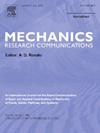Stability analysis of fluid conveying Timoshenko pipes resting on fractional viscoelastic foundations
IF 1.9
4区 工程技术
Q3 MECHANICS
引用次数: 0
Abstract
This study examines the dynamic stability of short cantilevered pipes carrying flow mounted on fractional viscoelastic foundations. The Timoshenko beam theory and a fractional Zener model are employed to model the tubular structure of the pipe as well as the viscoelastic foundation. Assuming the plug-flow assumptions, the effect of fluid flow is taken into account as a laterally distributed load, being a function of the pipe’s deformation states and their respective derivatives. The extended Hamilton’s principle is then used to obtain the motion equations. In order to solve the given equations of motion, a combination of the extended Galerkin and Laplace methods are employed to map the differential equations of motion to a set of equivalent algebraic equations. Therefore, to obtain the non-trivial solution of the problem and the pipe’s stability margins, the determinant of the coefficients of the retrieved algebraic equations is set to zero. Both real and imaginary components of the characteristic solutions are determined for a variety of parameter variations to check for stability thresholds. Several different parameters such as mass parameter, slenderness ratio, Poisson’s ratio, inner-to-outer radius ratio, fractional order parameter, foundation stiffness, and damping parameters are examined and some conclusions are drawn.
本研究探讨了安装在分数粘弹性地基上的短悬臂管道的动态稳定性。采用季莫申科梁理论和分数齐纳模型对管道的管状结构和粘弹性地基进行建模。假定采用塞流假设,流体流动的影响被视为横向分布的载荷,是管道变形状态及其各自导数的函数。然后利用扩展的汉密尔顿原理求得运动方程。为了求解给定的运动方程,采用了扩展 Galerkin 法和拉普拉斯法的组合,将微分运动方程映射为一组等效代数方程。因此,为了获得问题的非三元解和管道的稳定裕度,检索代数方程系数的行列式被设为零。针对各种参数变化确定特征解的实部和虚部,以检查稳定性阈值。对质量参数、细长比、泊松比、内外半径比、分数阶参数、地基刚度和阻尼参数等几个不同参数进行了研究,并得出了一些结论。
本文章由计算机程序翻译,如有差异,请以英文原文为准。
求助全文
约1分钟内获得全文
求助全文
来源期刊
CiteScore
4.10
自引率
4.20%
发文量
114
审稿时长
9 months
期刊介绍:
Mechanics Research Communications publishes, as rapidly as possible, peer-reviewed manuscripts of high standards but restricted length. It aims to provide:
• a fast means of communication
• an exchange of ideas among workers in mechanics
• an effective method of bringing new results quickly to the public
• an informal vehicle for the discussion
• of ideas that may still be in the formative stages
The field of Mechanics will be understood to encompass the behavior of continua, fluids, solids, particles and their mixtures. Submissions must contain a strong, novel contribution to the field of mechanics, and ideally should be focused on current issues in the field involving theoretical, experimental and/or applied research, preferably within the broad expertise encompassed by the Board of Associate Editors. Deviations from these areas should be discussed in advance with the Editor-in-Chief.

 求助内容:
求助内容: 应助结果提醒方式:
应助结果提醒方式:


